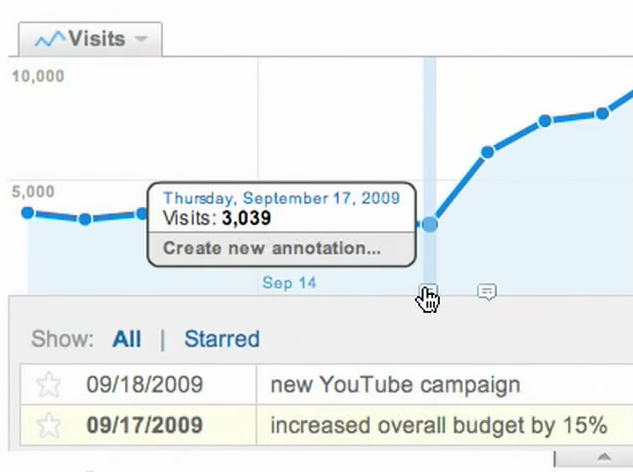
Do you struggle with making solid marketing decisions based on tangible data? If so you are not alone. We talk to a lot of business people who feel they are forced into making decisions on the fly and without tangible metrics to back up their chosen direction.
While I cannot solve all of your marketing conundrums, I can offer a suggestion that provides an option for viewing website traffic shifts and monitoring potential sources of such movement.
Within Google Analytics there is an easy to use feature called annotations. Google Analytics annotations are quick to implement and they can provide a powerhouse of data for marketers.
Have You Ever Asked One of These Questions?
- Did our website redesign help bounce rates?
- Did the pay per click campaign increase website conversions?
- Did that really expensive trade show drive any website traffic?
- Do you think that Google algorithm change hurt our website traffic?
If you have wondered about such things, I have a very simple way for you to start answering these questions with tangible data. And to make it even better, you can do so for free and right from within your Google Analytics dashboard.
Here’s Why You Should Use Annotations in Google Analytics
Google Analytics annotations can be used to record any type of event that can negatively or positively help such things as inbound website traffic, bounce rates, conversion rates, and revenue.
Real-world scenarios for using Google Analytics annotations include:
- Website redesigns
- Major shifts in content or website structure

- Modifications to website contact or lead forms
- Marketing campaign creation or stoppage
- Increase or decrease in a marketing budget
- Changes in pay per click, remarketing, or offline advertising
- Google penalty start or end
- Change in SEO, public relations, or other marketing consultants
- Attendance in industry events
- Industry shifts or developments
- Competitor activity
- Product launches
- In-house personnel changes
- Recording website outages, malware, or hosting issues
Pretty cool huh? Annotations are awesome because they can provide invaluable data.
I use annotations to track design changes to our website, updates to our core content, and modifications to our contact forms.
I encourage clients to use annotations to track their new website launch, trade show or conference attendance, shifts in email marketing programs, and most importantly, changes in internal employees who manage the website.
Let’s Deep Dive Into a Sample Usage of Google Analytics Annotations
Why would tracking personnel changes be important? Because a seemingly innocent employee can completely kill your on-page SEO without even knowing they are doing so. I have seen it time and time again.
While this also happens with web masters and content marketers, we’re going to pick on the SEO side of things today.
 Joe, your savvy new employee, swears he knows SEO when he is hired in so you give him keys to the website kingdom. Joe, without knowing it, quickly removes all SEO best practices as he makes the website more to his liking. He confuses Google, breaks hyperlinks, and removes keywords all in an effort to make himself a valued employee.
Joe, your savvy new employee, swears he knows SEO when he is hired in so you give him keys to the website kingdom. Joe, without knowing it, quickly removes all SEO best practices as he makes the website more to his liking. He confuses Google, breaks hyperlinks, and removes keywords all in an effort to make himself a valued employee.
This is a real example that I have witnessed more then once. Ok I’ve seen it a lot. And this is why I think tracking such data is important. If you were the marketing manager, wouldn’t it be nice to see this data shift in relationship to Joe’s arrival?
Because the data within annotations can help highlight a critical mistake, it is incredibly important and it makes it a powerful marketing tool.
Knowing Joe started on February 1st and he was given control of the website on February 15th might help shed some light on the sharp decrease in organic Google search traffic that happened on March 20th.
Having a small annotation in Google Analytics will show the events that could have triggered the decrease in traffic. In this case it is the fact that Joe has a user ID to your CMS solution and doesn’t know a thing about SEO.
Learn More About Using Annotations
I wish more people knew about annotations and used them to make better marketing decisions. I believe in them so much, that I will create them for clients anytime we launch a website and I have access to the client’s Google Analytics. I think they are that important.
If you’re ready to get started with annotations, get a feel for what you’re missing with the Google video below.
Then head on over to Google to learn more about Google Analytics annotations and how you can use them in your marketing programs.
Web Savvy Marketing
TwitterYoutubeFacebookLinkedinGoogle +